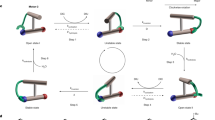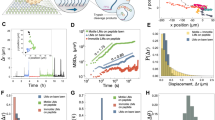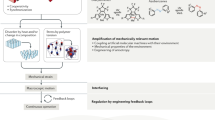Abstract
The conversion of energy into controlled motion plays an important role in both man-made devices and biological systems. The principles of operation of conventional motors are well established, but the molecular processes used by ‘biological motors’ such as muscle fibres, flagella and cilia1,2,3,4,5,6,7,8,9 to convert chemical energy into co-ordinated movement remain poorly understood10,11,12. Although ‘brownian ratchets’13,14,15,16 are known to permit thermally activated motion in one direction only, the concept of channelling random thermal energy into controlled motion has not yet been extended to the molecular level. Here we describe a molecule that uses chemical energy to activate and bias a thermally induced isomerization reaction, and thereby achieve unidirectional intramolecular rotary motion. The motion consists of a 120° rotation around a single bond connecting a three-bladed subunit to the bulky remainder of the molecule, and unidirectional motion is achieved by reversibly introducing a tether between the two units to energetically favour one of the two possible rotation directions. Although our system does not achieve continuous and fast rotation, the design principles that we have used may prove relevant for a better understanding of biological and synthetic molecular motors producing unidirectional rotary motion.
This is a preview of subscription content, access via your institution
Access options
Subscribe to this journal
Receive 51 print issues and online access
$199.00 per year
only $3.90 per issue
Buy this article
- Purchase on Springer Link
- Instant access to full article PDF
Prices may be subject to local taxes which are calculated during checkout





Similar content being viewed by others
References
Rayment,I. et al. Structure of the actin-myosin complex and its implications for muscle contraction. Science 261, 58–65 (1993).
Abrahams,J. P., Leslie,A. G. W., Lutter,R. & Walker,J. E. Structure at 2.8 Å resolution of F1-ATPase from bovine heart mitochondria. Nature 370, 621–628 (1994).
Dominguez,R., Freyzon,Y., Trybus,K. M. & Cohen,C. Crystal structure of a vertebrate smooth muscle myosin motor domain and its complex with the essential light chain: visualization of the pre-power stroke state. Cell 94, 559–571 (1998).
Block,S. M. Real engines of creation. Nature 386, 217–219 (1997).
Noji,H., Yasuda,R., Yoshida,M. & Kinoshita, K. Jr Direct observation of the rotation of F1-ATPase. Nature 386, 299–302 (1997).
Boyer,P. D. The ATP synthase—a splendid molecular machine. Annu. Rev. Biochem. 66, 717–749 (1997).
Shingyoji,C., Higuchi,H., Yoshimura,M., Katayama,E. & Yanagida,T. Dynein arms are oscillating force generators. Nature 393, 711–714 (1998).
Berg,H. C. Keeping up with F1-ATPase. Nature 394, 324–325 (1998).
Vale,R. D. & Oosawa,F. Protein motors and Maxwell's demons: does mechanochemical transduction involve a thermal ratchet? Adv. Biophys. 26, 97–134 (1990).
Stryer,L. in Biochemistry Ch. 15, 4th edn (W. H. Freeman, New York, 1995).
Howard,J. Molecular motors: structural adaptations to cellular functions. Nature 389, 561–567 (1997).
Huxley,A. How molecular motors work in muscle. Nature 391, 239–240 (1998).
Faucheux,L. P., Bourdieu,L. S., Kaplan,P. D. & Libchaber,A. J. Optical thermal ratchet. Phys. Rev. Lett. 74, 1504–1507 (1995).
Travis,J. Making light work of Brownian motion. Science 267, 1593–1594 (1995).
Astumian,R. D. Thermodynamics and kinetics of Brownian motion. Science 276, 917–922 (1997).
Rousselet,J., Salome,L., Ajdari,k A. & Prost,J. Directed motion of brownian particles induced by a periodic asymmetric potential. Nature 370, 446–448 (1994).
Mislow,K. Molecular machinery in organic chemistry. Chemtracts—Org. Chem. 2, 151–174 (1989).
Bedard,T. C. & Moore,J. S. Design and synthesis of molecular turnstiles. J. Am. Chem. Soc. 117, 10662–10671 (1995).
Balzani,V., Gomez-Lopez,M. & Stoddard,J. F. Molecular machines. Acc. Chem. Res. 31, 405–414 (1998).
Sauvage, J.-P. Transition metal-containing rotaxanes and catenanes in motion: toward molecular machines and motors. Acc. Chem. Res. 31, 611–619 (1998).
Bissell,R. A., Cordova,E., Kaifer,A. & Stoddart,J. F. A chemically and electrochemically switchable molecular shuttle. Nature 369, 133–137 (1994).
Benniston,A. C. & Harriman,A. A light-induced molecular shuttle based on a [2]rotaxane-derived triad. Angew. Chem. Int. Edn. Engl. 32, 1459–1461 (1993).
Mao,C., Sun,W., Shen,Z. & Seeman,N. C. A nanomechanical device based on the B-Z transition of DNA. Nature 397, 144–146 (1999).
Kelly,T. R., Tellitu,I. & Sestelo,J. P. In search of molecular ratchets. Angew. Chem. Int. Edn. Engl. 36, 1866–1868 (1997).
Kelly,T. R., Sestelo,J. P. & Tellitu,I. New molecular devices: in search of a molecular ratchet. J. Org. Chem. 63, 3655–3665 (1998).
Davis,A. P. Tilting at windmills? The second law survives. Angew. Chem. Int. Edn. Engl. 37, 909–910 (1998).
Musser,G. Taming Maxwell's demon. Sci. Am. 280, 24 (1999).
Kelly,T. R. et al. A molecular brake. J. Am. Chem. Soc. 116, 3657–3658 (1994).
Acknowledgements
We thank S. Jasmin and Y. Zhao for contributions to the preparation of necessary quantities of 2, and J. Sieglen and B. Wang for technical assistance. This work was supported by the NIH.
Author information
Authors and Affiliations
Corresponding author
Rights and permissions
About this article
Cite this article
Kelly, T., De Silva, H. & Silva, R. Unidirectional rotary motion in a molecular system. Nature 401, 150–152 (1999). https://doi.org/10.1038/43639
Received:
Accepted:
Issue Date:
DOI: https://doi.org/10.1038/43639
This article is cited by
-
Ratcheting synthesis
Nature Reviews Chemistry (2023)
-
Autonomous fuelled directional rotation about a covalent single bond
Nature (2022)
-
Insights from an information thermodynamics analysis of a synthetic molecular motor
Nature Chemistry (2022)
-
RETRACTED ARTICLE: Intrinsically unidirectional chemically fuelled rotary molecular motors
Nature (2022)
-
Simulating a chemically fueled molecular motor with nonequilibrium molecular dynamics
Nature Communications (2022)
Comments
By submitting a comment you agree to abide by our Terms and Community Guidelines. If you find something abusive or that does not comply with our terms or guidelines please flag it as inappropriate.



